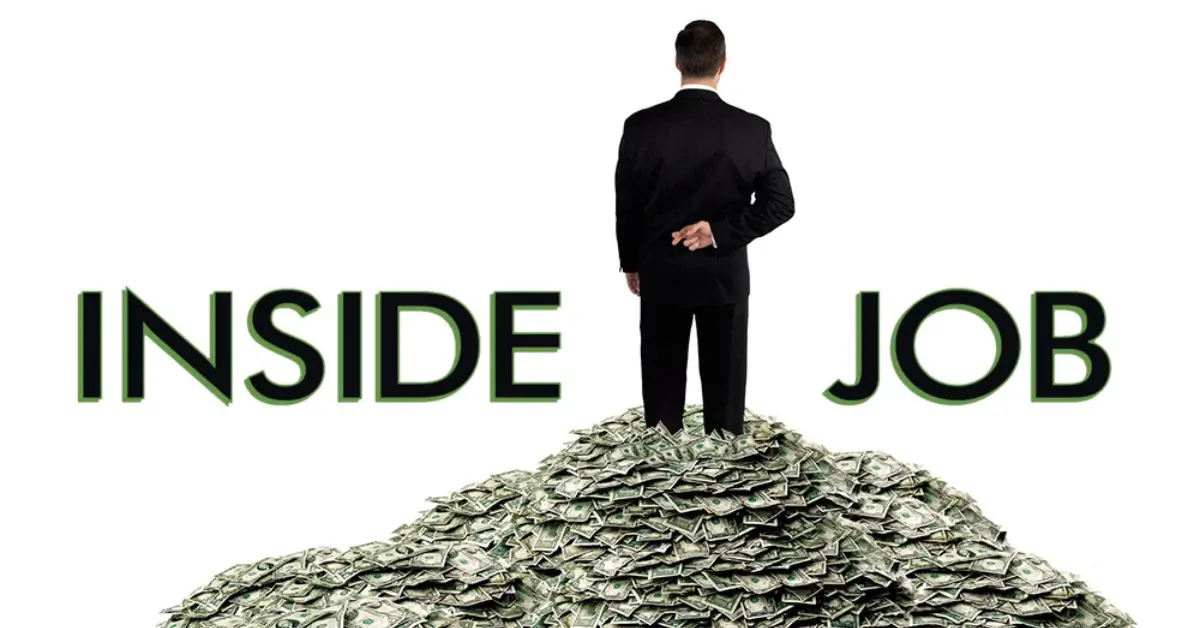Inside Job : The Psychological Toll of Financial Catastrophe
In the quiet moments before financial collapse, numbers whisper warnings that go unheard Charles Ferguson’s documentary doesn’t just explain a crisis, it dissects our collective psychosis of willful ignorance.
Thank you for reading this post, don't forget to subscribe!Introduction
Inside Job, Charles Ferguson’s meticulously crafted 2010 documentary, stands as perhaps the definitive cinematic examination of the 2008 global financial crisis. Beyond its economic analysis, the film offers a profound exploration of the psychological dimensions of financial catastrophe the denial, greed, and systemic delusion that enabled the collapse. Through expert testimony and damning evidence, Ferguson constructs not just an economic narrative but a psychological profile of an industry that lost its ethical moorings. The documentary raises crucial questions about mental health in high-pressure financial environments, cognitive dissonance among experts, and the psychological impact of economic devastation on ordinary citizens.
As we watch the architects of disaster defend their actions with straight faces, we confront an unsettling question: What kind of collective mindset allows such catastrophic self-deception to flourish?
Basic Film Information
Title: Inside Job
Release Date & Production Year: October 8, 2010
Director: Charles Ferguson (previously directed “No End in Sight” about the Iraq War; known for tackling complex systemic failures)
Screenwriter: Charles Ferguson, Chad Beck, Adam Bolt (crafting a narrative that balances technical complexity with emotional resonance)
Main Cast: Matt Damon (narrator), numerous financial industry insiders, economists, politicians, and journalists appearing as themselves
Genre: Documentary
Awards: Academy Award for Best Documentary Feature (2011), Directors Guild of America Award for Outstanding Directorial Achievement in Documentary
Runtime & Rating: 108 minutes, PG-13 (for some drug and sex-related material)
Plot Summary
Inside Job methodically chronicles the events leading to the 2008 global financial crisis through five parts: How We Got Here, The Bubble, The Crisis, Accountability, and Where We Are Now. Rather than presenting a simple chronology, Ferguson constructs a psychological narrative that reveals how intelligent, educated professionals participated in or failed to prevent a system-wide failure.
The documentary explores the mental health dimensions of the crisis from multiple angles. It examines the psychological environment of Wall Street where risk-taking behavior was rewarded and warning signs dismissed. The film suggests patterns consistent with denial, rationalization, and cognitive dissonance among financial leaders who maintained optimistic public statements while privately acknowledging danger.
Key turning points focus on moments when psychological factors overwhelmed rational decision-making: the dismissal of regulators who raised alarms, the willful blindness of rating agencies, and the academic economists who provided intellectual cover for dangerous practices. The documentary particularly highlights the psychological disconnect between those who understood the mounting risks and the organizational cultures that prevented meaningful action.
The film concludes with an assessment of the aftermath, noting the lack of significant reform and the psychological toll on millions of ordinary people who lost homes, jobs, and savings. This ending offers little resolution, suggesting instead that the psychological patterns that enabled the crisis remain largely unaddressed.
Setting & Cinematic Techniques
The camera glides through the gleaming corridors of financial power marble lobbies and panoramic corner offices filmed with cold precision. These aren’t just establishing shots; they’re visual metaphors for the psychological isolation of financial elites from the consequences of their decisions.
Ferguson employs distinct visual language to communicate psychological states. Interviews with financial insiders take place in settings of wealth and power, filmed with static compositions suggesting stability and control. In contrast, footage of foreclosed neighborhoods features handheld movements and desaturated colors that evoke psychological distress.
The documentary’s sound design subtly reinforces psychological themes. During segments explaining complex financial instruments, the score creates tension that mirrors the mounting anxiety of a system approaching collapse. When featuring the human cost of the crisis foreclosures, unemployment, disrupted lives the music becomes more emotionally resonant, drawing viewers into the psychological trauma experienced by victims.
Most effective is Ferguson’s use of interview techniques to reveal psychological states. The camera holds uncomfortably long on subjects showing signs of defensiveness shifting eyes, nervous laughter, barely contained anger creating moments where body language contradicts verbal assertions, revealing the psychological strain of maintaining contradictory positions.
Acting & Character Portrayal
While documentaries don’t feature “acting” in the traditional sense, Inside Job presents a remarkable study in self-portrayal. Financial executives, politicians, and economists essentially perform versions of themselves, sometimes revealing more than intended. Former Federal Reserve Chairman Alan Greenspan displays subtle signs of cognitive dissonance as he acknowledges “flaws in the model” of his worldview. Investment banker responses to questions about conflicts of interest demonstrate psychological defense mechanisms denial, projection, and rationalization.
Matt Damon’s narration provides a measured counterpoint to these performances, his voice maintaining steady control while describing increasingly outrageous behavior. This creates a powerful contrast between emotional neutrality and the content being described, allowing viewers to experience their own psychological reactions.
Most compelling are the moments when subjects appear genuinely stunned by questioning, as when academic economists are confronted about conflicts of interest. Their visible discomfort defensive postures, stammering responses, flashes of indignation offers a window into minds unable to reconcile professional identity with ethical contradictions.
Mental Health Representation: Strengths & Weaknesses
The true pathology Inside Job diagnoses isn’t found in DSM classifications but in organizational cultures where moral hazard became not just accepted but incentivized a collective madness masquerading as rational self-interest.
Inside Job’s greatest strength lies in its portrayal of how environments shape mental health and decision-making. The film illustrates how industry culture normalized excessive risk-taking and ethical compromises, creating psychological environments where warning signs were dismissed and dissenting voices marginalized. This systems-level approach avoids simplistic “bad apple” explanations, instead examining how organizational psychology enabled crisis.
The documentary effectively portrays the psychological aftermath for ordinary citizens anxiety, depression, and trauma following job loss and foreclosure. Brief but powerful segments feature individuals discussing their shattered sense of security and future, illustrating how financial crisis translates into mental health crisis at both individual and community levels.
However, the film’s weakness lies in not consulting mental health experts to provide context. While Ferguson convincingly demonstrates psychological patterns, including formal perspectives from psychologists could have strengthened the analysis of group dynamics, cognitive bias, and the psychological impact of financial instability.
Additionally, the documentary occasionally risks portraying financial leaders as one-dimensional villains rather than complex individuals operating within problematic systems, potentially oversimplifying the psychological factors at play in their decision-making.
Critical Reception & Awards
Inside Job received near-universal critical acclaim, with particular praise for its ability to make complex financial concepts accessible while maintaining emotional impact. The film holds a 98% rating on Rotten Tomatoes, with critics specifically noting its psychological dimensions.
A.O. Scott of The New York Times praised the film for revealing “the intellectual corruption that characterized and continues to characterize so much of the financial world.” Roger Ebert noted the documentary’s psychological insight, writing that it “indicts not just particular persons but a climate of ethical permissiveness.”
The documentary’s Academy Award for Best Documentary Feature validated its approach, while financial industry responses proved more mixed. Some acknowledged its accuracy, while others criticized what they perceived as oversimplification. Mental health professionals generally praised the film’s portrayal of systemic issues while noting it could have more explicitly addressed the psychological trauma experienced by those affected.
Cultural & Social Impact
Inside Job significantly influenced public discourse about the financial crisis, providing a psychological framework for understanding complex events. The film helped shape a narrative of institutional failure rather than isolated misconduct, contributing to broader cultural conversations about accountability and reform.
The documentary sparked particular discussion within academic economics, raising uncomfortable questions about conflicts of interest and intellectual capture. Several universities subsequently strengthened disclosure requirements for faculty consulting with financial firms, acknowledging the psychological and ethical complexities highlighted in the film.
In mental health contexts, Inside Job provided a valuable case study in organizational psychology and the mental health impacts of economic instability. Some therapists reported using the film to help clients understand systemic factors contributing to personal financial trauma, reducing self-blame among those affected by the crisis.
Personal Reflection & Final Thoughts
Inside Job offers profound insight into how intelligent systems can produce disastrous outcomes when psychological factors denial, greed, rationalization override analytical thinking. The documentary forces viewers to consider how environments shape perception and decision-making, often in ways that become visible only after catastrophe.
For those struggling with financial anxiety or the psychological aftermath of economic hardship, the film provides context that can be both validating and disturbing. It confirms that individual suffering often stems from systemic failures rather than personal shortcomings, yet offers little reassurance that these systems have been meaningfully reformed.
What could have been improved is the film’s exploration of resilience and recovery both individual and systemic. By focusing primarily on diagnosis rather than treatment, Inside Job leaves viewers with clarity about problems but limited vision of potential solutions, particularly regarding the psychological dimensions of financial stability.
Conclusion
Charles Ferguson’s Inside Job stands as both economic history and psychological case study a documentary that illuminates not just what happened in 2008 but how it could happen despite numerous warnings. Through its examination of institutional culture, conflicts of interest, and the human cost of financial collapse, the film offers crucial insights into the psychological dimensions of economic systems.
The documentary’s enduring significance lies in its demonstration that financial crises are never merely technical failures but human ones rooted in psychology, incentives, and collective belief systems. As we continue navigating uncertain economic landscapes, Inside Job reminds us that understanding financial stability requires attending not just to economic indicators but to the psychological environments in which decisions are made.
Perhaps most disturbingly, the film suggests that many of the psychological patterns that enabled the 2008 crisis remain unaddressed denial still flourishes, conflicts persist, and the gap between financial abstractions and human consequences continues to widen. This recognition invites viewers to consider their own relationship with financial systems and the psychological resilience needed to navigate them wisely.
How did Inside Job change your understanding of the financial crisis? Did it alter your perception of the psychological factors in economic systems? Share your thoughts in the comments below.

